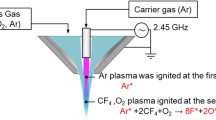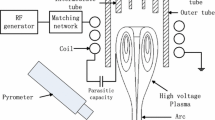Abstract
The modern optics industry demands rigorous surface quality with minimum defects, which presents challenges to optics machining technologies. There are always certain defects on the final surfaces of the components formed in conventional contacting machining processes, such as micro-cracks, lattice disturbances, etc. It is especially serious for hard-brittle functional materials, such as crystals, glass and ceramics because of their special characteristics. To solve these problems, the atmospheric pressure plasma polishing (APPP) method is developed. It utilizes chemical reactions between reactive plasma and surface atoms to perform atom-scale material removal. Since the machining process is chemical in nature, APPP avoids the surface/subsurface defects mentioned above. As the key component, a capacitance coupled radio-frequency plasma torch is first introduced. In initial operations, silicon wafers were machined as samples. Before applying operations, both the temperature distribution on the work-piece surface and the spatial gas diffusion in the machining process were studied qualitatively by finite element analysis. Then the following temperature measurement experiments demonstrate the formation of the temperature gradient on the wafer surface predicted by the theoretical analysis and indicated a peak temperature about 90°C in the center. By using commercialized form talysurf, the machined surface was detected and the result shows regular removal profile that corresponds well to the flow field model. Moreover, the removal profile also indicates a 32 mm3/min removal rate. By using atomic force microscopy (AFM), the surface roughness was also measured and the result demonstrates an Ra 0.6 nm surface roughness. Then the element composition of the machined surface was detected and analyzed by X-ray photoelectron spectroscopy (XPS) technology. The results also demonstrate the occurrence of the anticipated main reactions. All the experiments have proved that this atmospheric pressure plasma polishing method has the potential to achieve the manufacture of high quality optical surfaces.
Similar content being viewed by others
References
Gao H G, Cao J L, Zhu Y, et al. The development and application of ultra-smooth surfaces. Physics, 2000, 29(10): 610–614 (in Chinese)
Gao H G, Chen B, Cao J L. Fabricating technology for supersmooth surfaces. Optics and Precision Engineering, 1995, 3(4): 7–14 (in Chinese)
Li X S, Ge H Z. Machining technologies for ultra-smooth surfaces. Laser and Optoelectronics Progress, 1998, 35(11): 1–9 (in Chinese)
Carr J W. Atmospheric pressure plasma processing for damage-free optics and surfaces. Engineering Research Development and Technology, 1999, 3: 31–39
Mori Y, Yamamura K, Endo K,et al. Creations of perfect surfaces. Journal of Crystal Growth, 2005, 275(1–2): 39–50
Mori Y, Yamauchi K, Yamamura K, et al. Development of plasma chemical vaporization machining. Review of Scientific Instruments, 2000, 71(12): 4627–4632
Zhang J F, Wang B, Dong S. A new development of ultrasmooth surface machining technology. Optical Technique, 2007, 33(suppl): 150–154 (in Chinese)
Zhang J F, Wang B, Dong S. Process monitoring and analysis in the atmospheric pressure plasma polishing (APPP) method. In: Yang L, Chen Y L, Kley E B, et al, eds. Advanced Optical Manufacturing Technologies. Chengdu: SPIE, 2008, 67220O
Zhang J F, Wang B, Dong S. The design of an atmospheric pressure plasma torch used for polishing ultra-smooth surfaces. Key Engineering Materials, 2008, 346–366: 340–345
Ke Y K, Dong H R. Analytical Chemistry Manual (III): Spectral Analysis. 2nd ed. Beijing: Chemical Industry Press, 1998, 50 (in Chinese)
Ke Y K, Dong H R. Analytical Chemistry Manual (III): Spectral Analysis. 2nd ed. Beijing: Chemical Industry Press, 1998, 19 (in Chinese)
Fanara C, Shore P, Nicholl J R. A new reactive atom plasma technology (RART) for precision machining: the etching of ULE optical surfaces. In: Eli A E eds. Opto-mechanical Technologies for Astronomy. Joseph Antebi and Dietrich Lemke: SPIE, 2006, 62730A
Okada H, Inagaki K, Goto H, et al. First-principles moleculardynamics calculations and STM observations of dissociative adsorption of Cl2 and F2 on Si(100) surface. Surface Science, 2002, 515(2–3): 287–295
Carter L E, Carter E A. F2 reaction dynamics with defective Si(100): defect-insensitive surface chemistry. Surface Science, 1995, 323(1–2): 39–50
Shibahara M, Katsuki M. Molecular dynamics study of the effects of adsorbedmolecules on reaction probability and energy transfer. Combustion and Flame, 2006, 144(1–2): 17–23
Author information
Authors and Affiliations
Corresponding author
Additional information
__________
Translated from Optics and Precision Engineering, 2007, 15(11): 1749–1755 [译自: 光学精密工程]
About this article
Cite this article
Zhang, J., Wang, B. & Dong, S. Application of atmospheric pressure plasma polishing method in machining of silicon ultra-smooth surfaces. Front. Electr. Electron. Eng. China 3, 480–487 (2008). https://doi.org/10.1007/s11460-008-0072-9
Published:
Issue Date:
DOI: https://doi.org/10.1007/s11460-008-0072-9




